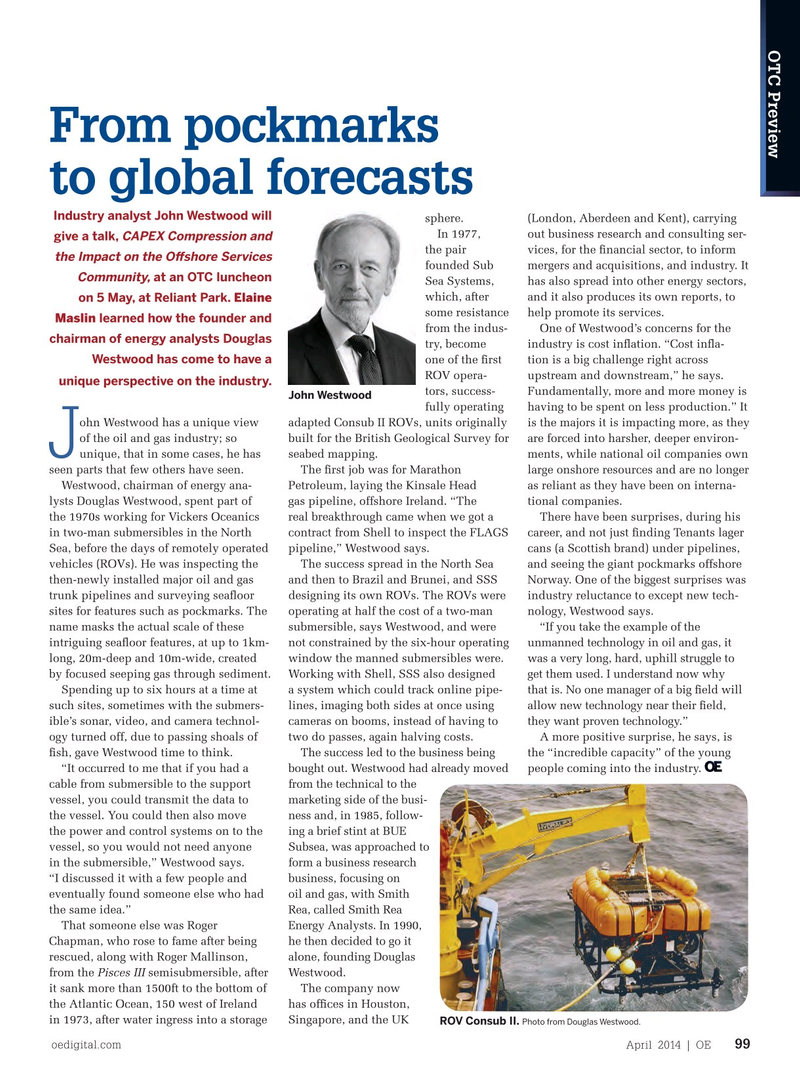
Page 97: of Offshore Engineer Magazine (Apr/May 2014)
Read this page in Pdf, Flash or Html5 edition of Apr/May 2014 Offshore Engineer Magazine
OTC Preview
From pockmarks to global forecasts
Industry analyst John Westwood will sphere. (London, Aberdeen and Kent), carrying
In 1977, out business research and consulting ser-
CAPEX Compression and give a talk, the pair vices, for the fnancial sector, to inform the Impact on the Ofshore Services founded Sub mergers and acquisitions, and industry. It at an OTC luncheon
Community,
Sea Systems, has also spread into other energy sectors, which, after and it also produces its own reports, to on 5 May, at Reliant Park. Elaine some resistance help promote its services.
Maslin learned how the founder and from the indus- One of Westwood’s concerns for the chairman of energy analysts Douglas try, become industry is cost infation. “Cost infa-
Westwood has come to have a one of the frst tion is a big challenge right across
ROV opera- upstream and downstream,” he says. unique perspective on the industry.
tors, success- Fundamentally, more and more money is
John Westwood fully operating having to be spent on less production.” It ohn Westwood has a unique view adapted Consub II ROVs, units originally is the majors it is impacting more, as they of the oil and gas industry; so built for the British Geological Survey for are forced into harsher, deeper environ-
J unique, that in some cases, he has seabed mapping. ments, while national oil companies own seen parts that few others have seen. The frst job was for Marathon large onshore resources and are no longer
Westwood, chairman of energy ana- Petroleum, laying the Kinsale Head as reliant as they have been on interna- lysts Douglas Westwood, spent part of gas pipeline, offshore Ireland. “The tional companies.
the 1970s working for Vickers Oceanics real breakthrough came when we got a There have been surprises, during his in two-man submersibles in the North contract from Shell to inspect the FLAGS career, and not just fnding Tenants lager
Sea, before the days of remotely operated pipeline,” Westwood says. cans (a Scottish brand) under pipelines, vehicles (ROVs). He was inspecting the The success spread in the North Sea and seeing the giant pockmarks offshore then-newly installed major oil and gas and then to Brazil and Brunei, and SSS Norway. One of the biggest surprises was trunk pipelines and surveying seafoor designing its own ROVs. The ROVs were industry reluctance to except new tech- sites for features such as pockmarks. The operating at half the cost of a two-man nology, Westwood says. name masks the actual scale of these submersible, says Westwood, and were “If you take the example of the intriguing seafoor features, at up to 1km- not constrained by the six-hour operating unmanned technology in oil and gas, it long, 20m-deep and 10m-wide, created window the manned submersibles were. was a very long, hard, uphill struggle to by focused seeping gas through sediment. Working with Shell, SSS also designed get them used. I understand now why
Spending up to six hours at a time at a system which could track online pipe- that is. No one manager of a big feld will such sites, sometimes with the submers- lines, imaging both sides at once using allow new technology near their feld, ible’s sonar, video, and camera technol- cameras on booms, instead of having to they want proven technology.” ogy turned off, due to passing shoals of two do passes, again halving costs. A more positive surprise, he says, is fsh, gave Westwood time to think. The success led to the business being the “incredible capacity” of the young “It occurred to me that if you had a bought out. Westwood had already moved people coming into the industry. cable from submersible to the support from the technical to the vessel, you could transmit the data to marketing side of the busi- the vessel. You could then also move ness and, in 1985, follow- the power and control systems on to the ing a brief stint at BUE vessel, so you would not need anyone Subsea, was approached to in the submersible,” Westwood says. form a business research “I discussed it with a few people and business, focusing on eventually found someone else who had oil and gas, with Smith the same idea.” Rea, called Smith Rea
That someone else was Roger Energy Analysts. In 1990,
Chapman, who rose to fame after being he then decided to go it rescued, along with Roger Mallinson, alone, founding Douglas from the Pisces III semisubmersible, after Westwood. it sank more than 1500ft to the bottom of The company now the Atlantic Ocean, 150 west of Ireland has offces in Houston, in 1973, after water ingress into a storage Singapore, and the UK
ROV Consub II. Photo from Douglas Westwood.
oedigital.com April 2014 | OE 99 096_OE0414_OTCPreview.indd 99 3/23/14 3:42 PM

 96
96

 98
98